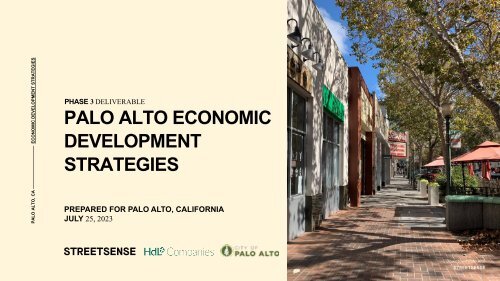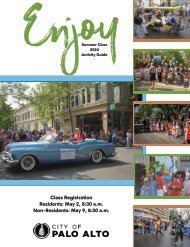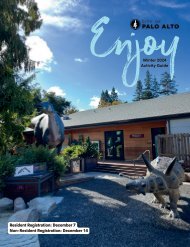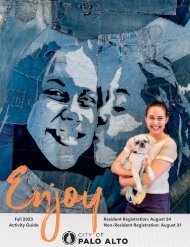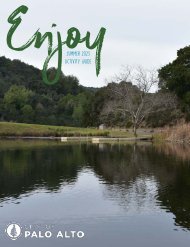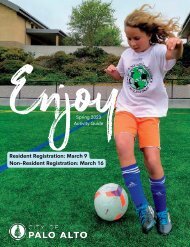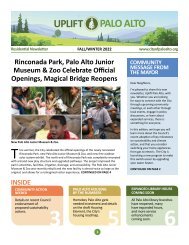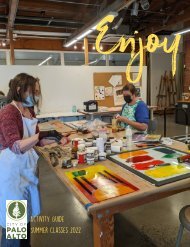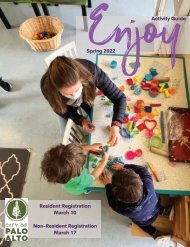Palo Alto Economic Development Strategies
You also want an ePaper? Increase the reach of your titles
YUMPU automatically turns print PDFs into web optimized ePapers that Google loves.
PALO ALTO, CA —————————— ECONOMIC DEVELOPMENT STRATEGIES<br />
PHASE 3 DELIVERABLE<br />
PALO ALTO ECONOMIC<br />
DEVELOPMENT<br />
STRATEGIES<br />
PREPARED FOR PALO ALTO, CALIFORNIA<br />
JULY 25, 2023<br />
Downtown <strong>Palo</strong> <strong>Alto</strong>
ACKNOWLEDGEMENTS<br />
STAFF<br />
CITY OF PALO ALTO CITY COUNCIL<br />
Ed Shikada, City Manager<br />
Kiely Nosé, Assistant City Manager<br />
Jonathan Lait, Planning and <strong>Development</strong> Services Director<br />
Brad Eggleston, Public Works Director<br />
Philip Kamhi, Chief Transportation Official<br />
Ozzy Arce, Senior Transportation Planner<br />
Nathan Baird, Parking Manager<br />
Holly Boyd, Assistant Director, Public Works<br />
Amy French, Chief Planning Official<br />
Jodie Gerhardt, Manager of Current Planning<br />
Steve Guagliardo, Assistant to the City Manager<br />
Sylvia Star-Lack, Transportation Planning Manager<br />
STAKEHOLDER INTERVIEWS<br />
John Aikin, Executive Director, <strong>Palo</strong> <strong>Alto</strong> Junior Museum & Zoo<br />
Shweta Bhatnagar, Director, Government Affairs, Stanford University<br />
Andrea Boca, Director of Operations, Urban Village Farmers’ Market<br />
Michael Bordoni, Director of Asset Management,<br />
Stanford University Real Estate<br />
Nancy Coupal, Coupa Café<br />
Brad Ehikian, Premier Properties<br />
Bruce Fukuji, Founding Principal, Urban Design Innovations<br />
Sheri Furman, <strong>Palo</strong> <strong>Alto</strong> Neighborhoods<br />
Annete Glanckopf, <strong>Palo</strong> <strong>Alto</strong> Neighborhoods<br />
Tiffany Griego, Managing Director of Asset Management,<br />
Stanford Research Park<br />
Karen Holman, Director, Midpeninsula Regional Open Space<br />
District and former Mayor of <strong>Palo</strong> <strong>Alto</strong><br />
Mayor Lydia Kou<br />
Vice Mayor Greer Stone<br />
Council Member Pat Burt<br />
Council Member Ed Lauing<br />
Council Member Julie Lythcott-Haims<br />
Council Member Greg Tanaka<br />
Council Member Vicki Veenker<br />
Karen Kienzle, Director, <strong>Palo</strong> <strong>Alto</strong> Art Center<br />
Jamie Jarvis, Stanford Research Park<br />
Steve Levy, Center for Continuing Study of the California Economy<br />
Ron Pardini, Executive Director, Urban Village Farmers’ Market<br />
Roxy Rapp, Founder/President, Rapp <strong>Development</strong><br />
John Shenk, Thoits Brothers<br />
Terry Schuchat<br />
Greg St. Claire, Nola’s<br />
Chris Suarez, Sales Manager, Nobu Hotel <strong>Palo</strong> <strong>Alto</strong><br />
Vikram Vinjay, Former Hotel General Manager, Graduate Hotels<br />
Charlie Weidanz, <strong>Palo</strong> <strong>Alto</strong> Chamber of Commerce<br />
641 S ST NW<br />
WASHINGTON, DC 20001<br />
STREETSENSE.COM<br />
@REALSTREETSENSE<br />
v<br />
PALO ALTO, CA —————————— ECONOMIC DEVELOPMENT STRATEGIES<br />
2
TABLE OF CONTENTS<br />
01 INTRODUCTION…………………………………………………….<br />
Purpose<br />
Trends and Opportunities<br />
Study Area<br />
Process<br />
02 DIAGNOSTIC OVERVIEW………………………………………….<br />
Retail Market Assessment<br />
Business Environment Assessment<br />
Administrative Assessment<br />
Physical Environment Assessment<br />
03 STRATEGIES………………………………………………………….<br />
Stakeholder Engagement, Guiding Principles and Strategy Organization<br />
At-A-Glance Strategy Recommendations<br />
Strategy Implementation and Best Practices<br />
04<br />
08<br />
15<br />
641 S ST NW<br />
WASHINGTON, DC 20001<br />
STREETSENSE.COM<br />
@REALSTREETSENSE<br />
v<br />
PALO ALTO, CA —————————— ECONOMIC DEVELOPMENT STRATEGIES<br />
3
PALO ALTO, CA —————————— ECONOMIC DEVELOPMENT STRATEGIES<br />
01<br />
INTRODUCTION<br />
4
INTRODUCTION<br />
PURPOSE<br />
Washington D.C.-based Streetsense and Brea, California-based HdL Companies (the<br />
Consultants) were engaged in the fall of 2022 to develop market-informed economic<br />
development strategies that will ensure <strong>Palo</strong> <strong>Alto</strong>’s on-going regional competitiveness by<br />
identifying impactful public sector interventions and investments for which there is both need<br />
and consensus for action. The strategies presented herein aim to reflect the delicate ecosystem<br />
that drives the vibrancy of the City’s Downtown and commercial centers with a focus on the<br />
retail and hospitality sectors, those significantly affected by the COVID-19 pandemic and<br />
resulting hybrid work environment.<br />
TRENDS and OPPORTUNITIES<br />
Global and national retail trends suggest major changes to traditional retail relationships due<br />
to on-line sales, changes to the shopping experience, and hybrid work. The COVID-19<br />
pandemic has accelerated these changes resulting in:<br />
• Reduced demand for storefront space as use of the internet and home delivery increases<br />
in popularity;<br />
• Smaller format retail spaces in higher quality locations due to streamlined inventory<br />
made possible by advances in technology and more sophisticated supply chain;<br />
• Changes in how tenants value the ‘flagship’ store as social media diminishes the need<br />
for a physical presence;<br />
• Increasing resident and visitor desire for memorable experiences unable to be replicated<br />
in on-line environments;<br />
• More demand for non-traditional business hours and locations as the former nine to five<br />
work routine is no longer the norm; and<br />
• Reinforced neighborhood scale shopping and gathering for daily essential needs.<br />
Notably, brick and mortar retail of various scales and offerings is here to stay but in enduring<br />
places that guarantee a strong customer base. For <strong>Palo</strong> <strong>Alto</strong>, residents are among the most<br />
affluent and educated in the region. These discerning customers have high expectations and<br />
many local and regional options for spending their time and money, which may or may not be<br />
inside <strong>Palo</strong> <strong>Alto</strong>’s borders. Significantly, retail tenants are increasingly more selective about<br />
where they decide to locate to reach that customer base. Ultimately, <strong>Palo</strong> <strong>Alto</strong>’s Downtown<br />
and commercial centers must aim to reinvent themselves to remain competitive, and <strong>Palo</strong><br />
<strong>Alto</strong> must strive to be supportive in an effort to maintain and grow the tax base.<br />
PALO ALTO, CA —————————— ECONOMIC DEVELOPMENT STRATEGIES<br />
As such, the economic development strategies to follow will inform future resource<br />
allocation, policy and programming decisions for the City of <strong>Palo</strong> <strong>Alto</strong> and their partners to<br />
take toward achieving a balanced and competitive future.<br />
Downtown <strong>Palo</strong> <strong>Alto</strong><br />
Source: Streetsense<br />
5
INTRODUCTION<br />
STUDY AREA<br />
The study focuses on areas within <strong>Palo</strong> <strong>Alto</strong> where there is existing concentration of retail<br />
activity and representative of the diverse scale of retail offerings found throughout the City.<br />
The following descriptions include three categories of shopping districts according to<br />
shopping center industry classifications.<br />
REGIONAL/SUPER-REGIONAL CENTERS<br />
DOWNTOWN and STANFORD SHOPPING CENTER<br />
• Most significant tax base contributors<br />
• Face the greatest competition for visitors within the region<br />
• Must maintain "best-in-class" status to remain competitive<br />
COMMUNITY-SERVING CENTERS<br />
CALIFORNIA AVE and TOWN & COUNTRY VILLAGE<br />
• Moderate tax base impacts<br />
• Employs local promotion and marketing strategies, if any<br />
• Tend to benefit from activations that meet community interests and needs<br />
NEIGHBORHOOD-SERVING<br />
MIDTOWN and CHARLESTON SHOPPING CENTER<br />
• Minimal tax base impacts<br />
• Least affected by the COVID-19 pandemic and typically the most stable asset class<br />
• Local customer base with little need for promotion<br />
PROCESS and METHODOLOGY<br />
The strategies were informed by a multi-phased process with robust stakeholder engagement,<br />
starting with field work and a tour of the City’s commercial districts and destination assets,<br />
focus group discussions with residents, business and property owners, and hoteliers, and<br />
discussions with partners, including the Chamber of Commerce, Urban Village Farmer’s<br />
Markets, and several interdepartmental city staff. Within the initial phase, the Consultants<br />
performed background research and a trends assessment. A diagnostic followed consisting of<br />
1) a retail market assessment of regional/local competition and supply/demand, 2) a business<br />
environment assessment including a tax analysis and hospitality/tourism assessment, 3) an<br />
administrative assessment which analyzed existing policy and zoning requirements and<br />
organizational capacity, and 4) a physical assessment of all study area commercial districts.<br />
PALO ALTO, CA —————————— ECONOMIC DEVELOPMENT STRATEGIES<br />
Throughout the 12-month process, the Consultants engaged the City Council to ground truth<br />
findings and ultimately shape the final guiding principles and strategies.<br />
Source: Streetsense<br />
6
PALO ALTO, CA —————————— ECONOMIC DEVELOPMENT STRATEGIES<br />
Stanford Shopping Center<br />
Source: Streetsense<br />
7
PALO ALTO, CA —————————— ECONOMIC DEVELOPMENT STRATEGIES<br />
02<br />
DIAGNOSTIC OVERVIEW<br />
8
RETAIL MARKET ASSESSMENT<br />
The economic development strategies outlined herein represent a practical roadmap for public and private<br />
interventions that advance the City’s post-pandemic recovery of retail shopping districts. The following is a<br />
summary of the diagnostic conclusions that ultimately informed the guiding principles and recommended<br />
strategies. The full diagnostic can be found in the March 13, 2023 City Council Work Session Staff Report.<br />
REGIONAL and LOCAL RETAIL COMPETITION<br />
Regionally-serving, experience-based retail centers, including malls, power centers, and walkable downtowns and<br />
lifestyle centers, are characterized by a dominant mix of good-based retail. These retail centers attract customers<br />
from a larger regional trade area and feature a cluster of full-service restaurants and entertainment. There are five<br />
regional malls of varying quality closer to San Jose and only one traditional mall to the west, Hillsdale Shopping<br />
Center. Even with steep competition, the top performing mall in the region is Stanford Shopping Center. The<br />
region is also rich with competitive Downtown retail environments, including Downtown Menlo Park, Mountain<br />
View, Redwood City, Los <strong>Alto</strong>s, and Burlingame, which also compete with malls and lifestyle centers. Locally,<br />
Downtown <strong>Palo</strong> <strong>Alto</strong> not only competes with Stanford Shopping Center but also California Avenue, a more<br />
community serving retail environment, spreading retail quite thin across the City.<br />
Neighborhood serving retail centers are characterized by a dominant mix of Neighborhood Goods & Services<br />
(NG&S) tenants, often grocery-anchored. These retail centers primarily meet the need for convenience-based<br />
shopping trips competing on a geographically smaller scale. Grocery competition is strong throughout the region.<br />
Big box retailers are not permitted in <strong>Palo</strong> <strong>Alto</strong> by regulation but are concentrated along the periphery of <strong>Palo</strong> <strong>Alto</strong>,<br />
cannibalizing the retail offerings within the City. Target and Costco are particularly prevalent in the region, with<br />
nine and seven stores respectively within the studied area.<br />
RETAIL VACANCY and RENTS<br />
Vacancy among the six retail districts totals 243,000 square feet, or about 8% vacancy rate, as of year-end<br />
2022. A majority of vacant space is concentrated in Downtown <strong>Palo</strong> <strong>Alto</strong>, accounting for about 88,000 square<br />
feet. California Avenue has the highest vacancy rate among all districts at 15%, accounting for 31,000 square feet.<br />
There is about 57,000 square feet currently vacant within Stanford Shopping Center, which equates to a low<br />
vacancy of 4%, due to the mall's large size. This<br />
vacancy is caused by smaller tenants inside the<br />
mall rather than by the loss of an anchor. Most<br />
importantly, Stanford Shopping Center captures<br />
spending that might otherwise be spent in other<br />
<strong>Palo</strong> <strong>Alto</strong> districts, especially Downtown <strong>Palo</strong> <strong>Alto</strong>,<br />
by offering attractive co-tenancy opportunities, a<br />
high-amenity environment, and retail-appropriate<br />
spaces.<br />
Retail rents in the region are high with average<br />
asking rent at $63.52 per square foot, 130% higher<br />
than the national average of $27.55 per square foot Source – REIS, Loopnet, Michael Baker, CoStar 2022<br />
for malls and downtown environments. Stanford Shopping Center has the highest average asking rents in <strong>Palo</strong> <strong>Alto</strong><br />
at just over $77.00. Town & Country Village and Downtown <strong>Palo</strong> <strong>Alto</strong> are comparable with average rents at<br />
between roughly $72.00 and $76.00 per square foot, respectively.<br />
DEMAND<br />
Retail demand is based on resident, employee, overnight guest, and daytime visitor spending, local and regional<br />
competition, and projected population growth. Importantly, hybrid work has reduced the demand for retail in<br />
<strong>Palo</strong> <strong>Alto</strong> by over 100,000 square feet, roughly equivalent to the amount of retail space at Midtown and<br />
Charleston Shopping Center combined. The reduction in <strong>Palo</strong> <strong>Alto</strong>'s daytime population means less spending<br />
available to support retailers. That said, there is a significant development pipeline in the surrounding markets. At<br />
full build out, these projects will add 17,700 residential units, 15.8 million square feet of office/life science space,<br />
and 2,300+ hotel keys. The additional density and daytime population will improve these competitive markets,<br />
making them more compelling locations for retailers.<br />
At this time, 2032 projections suggest that <strong>Palo</strong> <strong>Alto</strong> can support approximately 2.7 million square feet, with 15%<br />
of total retail demand in Neighborhood Goods & Services (NG&S), 22% in Food & Beverage (F&B), and 63% in<br />
General Merchandise, Apparel, Furniture, and Other (GAFO). More specifically:<br />
• GAFO makes up more than half of demand, driven by Stanford Shopping Center, which consumes 80%,<br />
with a remaining 321,730 square feet of GAFO demand to be distributed among the other districts.<br />
• Neighborhood-serving retail demand is constrained by the presence of big box retailers just outside the<br />
City’s boundaries. However, given the population density and high spending levels, the market may be able<br />
to support additional neighborhood-serving retail on a small scale.<br />
• Food & Beverage is seeing healthy demand in fast casual serving student and employee populations, as<br />
well as full-service, sit-down restaurants.<br />
Retail demand will steadily increase;<br />
however, without intervention, demand will<br />
not reach parity with the existing retail<br />
supply over the next 10 years. Because of the<br />
460,000 square feet of projected oversupply,<br />
vacancy will continue to rise among lower<br />
quality or poorly positioned space.<br />
OPPORTUNTIIES<br />
To better support <strong>Palo</strong> <strong>Alto</strong>’s retail districts, a<br />
more balanced ecosystem of uses should be<br />
introduced to increase daytime population,<br />
activation, duration of stay, and spending. A<br />
broader mix of uses including residential,<br />
office space for sectors requiring more inperson<br />
work, entertainment, civic, and<br />
cultural uses are recommended.<br />
Source: Michael Baker; Streetsense analysis 2022<br />
PALO ALTO, CA —————————— ECONOMIC DEVELOPMENT STRATEGIES<br />
9
Millions<br />
BUSINESS ENVIRONMENT ASSESSMENT<br />
POST-PANDEMIC SALES TAX RECOVERY vs. SMALL BUSINESS RECOVERY<br />
Sales tax revenues are mostly back to pre-pandemic (FY 2018-19) numbers as of the end of FY 2021-22 at just 6%<br />
below. Sales tax recovery, alone, however, is not an absolute reflection of recovery and profitability. Many<br />
small, locally owned businesses, particularly restaurants, retailers, and personal service providers, were the hardest<br />
hit during the COVID-19 pandemic and are not yet back to pre-pandemic cash flow and required revenue<br />
margins. Inflation and the increasing costs of doing business, supply chain and manufacturing disruptions, rising<br />
interest rates, employment and labor shortages, the rise of online shopping, and hybrid work preferences all affect<br />
small business operations and overall recovery. Hybrid work environments are proliferating significantly in areas<br />
like <strong>Palo</strong> <strong>Alto</strong> where many small businesses previously relied upon the daytime population, primarily in the<br />
technology sector. The area encompassing the City of <strong>Palo</strong> <strong>Alto</strong>, including Stanford University and Stanford<br />
Research Park, have an average return to the office rate of 40% according to January 2023 Kastle Systems. While<br />
there is no “crystal ball”, credible experts suggest that the San Jose Metro area may not return to pre-pandemic inoffice<br />
levels. The impact to small businesses and sales tax will be felt for years to come without strategic<br />
intervention.<br />
SALES TAX ANALYSIS TAKEAWAYS<br />
Although total sales tax revenues are bouncing back from the pandemic, the local economy is not fully recovered<br />
and key tax generating districts are experiencing uneven recovery, as follows:<br />
• Neighborhood Serving Centers, Charleston Shopping Center and Midtown, were the least impacted<br />
during the pandemic as spending on essential needs found in grocery stores, pharmacies, and personal<br />
services remained strong. Together, they show the highest percentage of Neighborhood Goods & Services<br />
(NG&S) relative to the total sales tax revenue in those districts at 40% and 54% respectively. Because<br />
NG&S are not big sales tax producers – a grocery store’s taxable sales, for example, are roughly 25-30% of<br />
their total sales – these centers combined only made up about 1% of the City's total sales tax revenue in FY<br />
2021-22.<br />
• California Avenue makes up 2.2% of total sales tax in the City and is 12.8% below pre-pandemic sales in<br />
FY 2018-19 and 9% below FY 2016-17. A majority of California Avenue’s sales tax comes from Food &<br />
Beverage (F&B) at 74%, with nearly equal revenue from NG&S, General Merchandise, Apparel, Furniture<br />
& Other (GAFO), and Non-Retail establishments like business services and entertainment. This suggests an<br />
opportunity to diversify offerings to aid in sales tax recovery.<br />
• Downtown <strong>Palo</strong> <strong>Alto</strong>, which makes up 12% of total sales tax revenue in the City, was in decline prior to<br />
the pandemic and has been the slowest to recover from the pandemic with FY 2021-22 sales tax revenues<br />
25% below pre-pandemic FY 2016-17 sales. Among the six districts, Downtown <strong>Palo</strong> <strong>Alto</strong> produces the<br />
highest value of Food & Beverage (F&B) sales tax revenue, the retail category making up 11.4% of total<br />
sales tax for the City. It also brings in the second highest GAFO sales tax at $1.1 million, second only to<br />
Stanford Shopping Center.<br />
• Town & Country Village experienced a 21% decrease in sales tax in FY 2019-20, though the shopping<br />
area is recovering from the pandemic. As a community serving retail center offering a fairly equal mix of<br />
NG&S and F&B, and a small amount of GAFO, Town & Country Village sales tax make up 3% of the total<br />
sales tax revenue in <strong>Palo</strong> <strong>Alto</strong> for FY 2021-22.<br />
• Stanford Shopping Center has seen successful pandemic recovery with FY 2021-22 sales 25% above prepandemic<br />
FY 2016-17 sales tax revenues. It’s majority GAFO offerings contributed $5.1 million, the<br />
highest among the six districts, to the City’s 24% of total sales tax from GAFO. In total, Stanford Shopping<br />
Center makes up 25% of the City’s total sales tax revenue, mainly from retail sales.<br />
$7<br />
$6<br />
$5<br />
$4<br />
$3<br />
$2<br />
$1<br />
$0<br />
Sales Tax Revenues for Fiscal Years<br />
2016-17 to 2021-22<br />
FY 2017 FY 2018 FY 2019 FY 2020 FY 2021 FY 2022<br />
Charleston Shopping Center<br />
California Ave<br />
Downtown <strong>Palo</strong> <strong>Alto</strong><br />
Midtown<br />
Town & Country Village<br />
Stanford Shopping Center<br />
Source: HdL Companies<br />
RETAIL SALES and COMPETING CITIES<br />
An analysis of retail sales dollar per capita (SDPC) for FY 2021/22 was performed for <strong>Palo</strong> <strong>Alto</strong> and competing<br />
cities, including Redwood City, Mountain View, Burlingame, Menlo Park, and Los <strong>Alto</strong>s. <strong>Palo</strong> <strong>Alto</strong> has the lowest<br />
NG&S SDPC, even lower than Burlingame and Los <strong>Alto</strong>s who bring in less NG&S sales tax revenue compared to<br />
<strong>Palo</strong> <strong>Alto</strong>. Menlo Park has the highest SDPC in the NG&S category even though Redwood City and Mountain<br />
PALO ALTO, CA —————————— ECONOMIC DEVELOPMENT STRATEGIES<br />
10
BUSINESS ENVIRONMENT ASSESSMENT (cont.)<br />
View receive a significantly higher amount of NG&S sales tax revenue. This suggests that <strong>Palo</strong> <strong>Alto</strong> residents are<br />
likely shopping for neighborhood goods and services in competing areas, a conclusion shared by the locallyserving<br />
retail competition analysis.<br />
<strong>Palo</strong> <strong>Alto</strong> is doing better than most competing cities in bringing people to the City for F&B, and it has the highest<br />
SDPC in the GAFO category, largely due to the Stanford Shopping Center. As such, <strong>Palo</strong> <strong>Alto</strong> is likely bringing<br />
consumers from outside the area to shop for GAFO, mostly at Stanford Shopping Center, as well as non-retail sales<br />
tax producing goods and services, like auto and transportation and those from Stanford Research Park.<br />
Source: HdL Companies<br />
HOSPITALITY/TOURISM: LODGING, VISITORS, and OPPORTUNTIES<br />
Globally and domestically, business travel is returning to pre-pandemic levels despite hybrid work. <strong>Palo</strong> <strong>Alto</strong>’s<br />
lodging industry is recovering at the national pace and is currently approaching 2019 levels. <strong>Palo</strong> <strong>Alto</strong>’s<br />
Occupancy Rate is highest mid-week but slightly lower than either U.S. or California Average, overall. <strong>Palo</strong> <strong>Alto</strong>’s<br />
largest contributors to occupancy are medical, education, and business travelers who fill approximately 2,200 hotel<br />
rooms, including about 300 in <strong>Palo</strong> <strong>Alto</strong>’s two new Marriott properties.<br />
International travel recovery is slow nation-wide and will continue to impact <strong>Palo</strong> <strong>Alto</strong> more than most cities.<br />
Chinese visitors, in particular, were the largest source of international visitors to <strong>Palo</strong> <strong>Alto</strong> pre-pandemic, but<br />
China’s slow recovery lags all other major inbound traveler sources to California. <strong>Palo</strong> <strong>Alto</strong>’s largest audience<br />
sector for hospitality spending (restaurants, attractions, shopping) and tax revenue is a combination of residents<br />
and the workforce. Its next largest includes residents and workforce from neighboring Bay Area<br />
communities, such as Mountain View, Menlo Park, Sunnyvale, Redwood City, Burlingame, and Los <strong>Alto</strong>s. That<br />
said, weekend occupancy rates have<br />
historically remained low as <strong>Palo</strong> <strong>Alto</strong> is<br />
not a typical, overnight<br />
tourist destination with major destination<br />
attractions. However, there are<br />
unique local destinations to celebrate and<br />
promote for both domestic and extended<br />
business travel, or “bleisure” travel.<br />
Under-the-radar local assets, like the<br />
<strong>Palo</strong> <strong>Alto</strong> Junior Museum & Zoo, the<br />
<strong>Palo</strong> <strong>Alto</strong> Art Center, Stanford Theater,<br />
and the Baylands Nature Preserve, and<br />
the Municipal Golf Course and Airport,<br />
could be comprehensively promoted to<br />
attract longer visitation in the City.<br />
Source: Streetsense, Stanford Theatre<br />
<strong>Palo</strong> <strong>Alto</strong> Junior Museum & Zoo<br />
Source: Streetsense<br />
Source: Tourism <strong>Economic</strong>s; Streetsense<br />
Baylands Nature Preserve<br />
Source: Streetsense<br />
PALO ALTO, CA —————————— ECONOMIC DEVELOPMENT STRATEGIES<br />
11
Highly Regulated<br />
Environments<br />
ADMINISTRATIVE ASSESSMENT<br />
REGULATORY ASSESSMENT<br />
The regulatory assessment considers, first, <strong>Palo</strong> <strong>Alto</strong>’s 2030 Comprehensive Plan as it is the primary guide for<br />
preservation and development across the City. There are three sections in the Comprehensive Plan which provide<br />
economic development directives, and which recommended strategies aim to achieve:<br />
• Business & <strong>Economic</strong>s – strive to be "business friendly“;<br />
• Land Use – Updates to the municipal code that support a "diversification of land uses", including "retail<br />
that caters to daily needs of residents"; "stimulates housing near retail"; and allows for the "conversion of<br />
non-retail commercial FAR [floor area ratio] to residential FAR, where appropriate“; and<br />
• Transportation – Improve walkability and bikability by "improving connectivity between businesses,<br />
parking and transit stops", including "public art in alleyways" to encourage walking.<br />
To effectuate implementation of this policy guidance, the City has the tool of zoning. However, municipal zoning<br />
codes often evolve as a hodgepodge of regulatory solutions aimed at solving specific challenges at a given point in<br />
time. Although the code is periodically amended, it is often reactionary and not easily adaptable to swifter market<br />
changes. <strong>Palo</strong> <strong>Alto</strong>’s zoning code is representative of these characteristics. For example, rendering some sections<br />
of <strong>Palo</strong> <strong>Alto</strong>’s code outdated based on recent trends in retail and changing work patterns include:<br />
• Growth in on-line shopping – retailers are increasingly using stores for local distribution, which may be<br />
restricted as “warehousing & distribution”;<br />
• Technology advances – breweries, specialty food manufacturing and maker spaces may be restricted as<br />
“manufacturing & processing”; and<br />
• Demographic and lifestyle – wellness and medical services may be restricted as “medical office”.<br />
There are opportunities to make the code more “business friendly”. Downtown <strong>Palo</strong> <strong>Alto</strong>, California Avenue, and<br />
Neighborhood Centers, Midtown and Charleston Shopping Center, have between two and five zoning overlays of<br />
distinct regulations on top of base zone regulations, whereas Stanford Shopping Center and Town & Country<br />
Village only have one overlay.<br />
DISTRICT BASE DISTRICT OVERLAY 1 OVERLAY 2 OVERLAY 3 OVERLAY 4 OVERLAY 5<br />
CALIFORNIA AVE<br />
MIDTOWN &<br />
CHARLESTON<br />
SHOPPING CENTER<br />
DOWNTOWN<br />
(University Ave)<br />
DOWNTOWN<br />
(Lytton)<br />
TOWN & COUNTRY<br />
VILLAGE<br />
STANFORD SHOPPING<br />
CENTER<br />
CC – Community<br />
Commercial<br />
CN – Neighborhood<br />
Commercial<br />
CD – Downtown<br />
Commercial<br />
CD – Downtown<br />
Commercial<br />
CC – Community<br />
Commercial<br />
CC – Community<br />
Commercial<br />
Retail<br />
Preservation<br />
Retail<br />
Preservation<br />
Retail<br />
Preservation<br />
Retail<br />
Preservation<br />
Retail<br />
Preservation<br />
Retail<br />
Preservation<br />
R – Retail<br />
Shopping<br />
GF – Ground<br />
Floor<br />
GF – Ground<br />
Floor<br />
P – Pedestrian<br />
Shopping<br />
P – Pedestrian<br />
Shopping<br />
P – Pedestrian<br />
Shopping<br />
P – Pedestrian<br />
Shopping<br />
PTOD – Cal Ave<br />
Pedestrian and<br />
Transit Oriented<br />
Special Regulations<br />
governing proximity<br />
to Residential<br />
Cal Ave Parking<br />
Assessment<br />
District<br />
The layers of regulation cause confusion among property owners, developers, and tenants when trying to<br />
understand what they are allowed to do on their property, which adds time to approval and permitting processes,<br />
increases risk, and may prevent improvements and/or occupancy entirely. It is no surprise that the commercial<br />
districts experiencing the most difficulty recovering from the pandemic and experiencing the most vacancy include<br />
<strong>Palo</strong> <strong>Alto</strong>’s two most heavily regulated environments, Downtown <strong>Palo</strong> <strong>Alto</strong> and California Avenue.<br />
The Retail Preservation Ordinance, created in 2015 to restrict ground floor retail conversions city-wide to nonretail<br />
uses, is one example of a blunt rule that was created in response to temporary market conditions. The<br />
Ordinance was written as a response to concerns that higher paying office tenants were displacing ground floor<br />
retail, undermining <strong>Palo</strong> <strong>Alto</strong>’s retail businesses, who found it hard to compete. Market conditions at the time<br />
reflected record high commercial rental rates and low office vacancy rates at around 2.8%. In contrast, Silicon<br />
Valley’s and <strong>Palo</strong> <strong>Alto</strong>’s office market today is vastly different, with nearly 18% vacancy and 14% vacancy,<br />
respectively. With office occupancy rates not expected to fully recover to post-pandemic levels in the foreseeable<br />
future, the threat of retail space conversion to office is minimal, and the Ordinance and its geographic applicability<br />
should be reevaluated, especially in districts experiencing higher vacancy than others.<br />
ORGANIZATIONAL CAPACITY and STEWARDSHIP<br />
<strong>Palo</strong> <strong>Alto</strong> is well served by arts, culture, and entertainment agencies and organizations at both the city and district<br />
level, but <strong>Palo</strong> <strong>Alto</strong>’s economic development service delivery mechanisms are limited to the City and the <strong>Palo</strong><br />
<strong>Alto</strong> Chamber, a city-wide membership organization. Destination <strong>Palo</strong> <strong>Alto</strong>, a potentially effective website for<br />
city-wide destinations, restaurants, shops, and lodging, is defunct and no longer being updated. Because the<br />
website still exists, however, people can still visit it but will not be given accurate or up-to-date information, which<br />
in turn hurts the City’s brand and does little to uplift local, small, and new businesses.<br />
Furthermore, currently, neither Downtown <strong>Palo</strong> <strong>Alto</strong> nor California Avenue have active stewards to lead<br />
marketing, promotion, event coordination, enhanced sanitation and maintenance, or security above and beyond<br />
what the City is obligated to provide. Although suspended, there is an established charter for the Downtown <strong>Palo</strong><br />
<strong>Alto</strong> Business Improvement District (BID). Similarly, the California Avenue Business Association/Merchants of<br />
California Avenue is defunct.<br />
Internally, economic development is addressed across many departments as it is ingrained among many divisions,<br />
but there is only one dedicated economic development staff person among all city staff. The 2024 City Budget<br />
includes one additional full-time dedicated position constituting formation of a potential future Office of<br />
<strong>Economic</strong> <strong>Development</strong>, one that will need to grow to meet the demand for economic development efforts.<br />
Internal partners will be key to executing programs and initiatives recommended by strategies presented herein,<br />
but more dedicated staff are needed to execute executive, administrative and operating functions, and program<br />
implementation both from a leadership and support role.<br />
PALO ALTO, CA —————————— ECONOMIC DEVELOPMENT STRATEGIES<br />
Source: Streetsense<br />
12
PHYSICAL ASSESSMENT<br />
RE-INVESTMENT LIFECYCLE<br />
Physical attributes contributing to the look and feel of thriving commercial districts include multi-modal<br />
transportation networks that ensure equitable and safe accessibility, well-designed, pedestrian-friendly sidewalks,<br />
passageways, and gathering spaces, visibility and identification of place through thoughtful wayfinding and<br />
signage, well-maintained buildings and public spaces, and, finally, apparent overall cleanliness. The investments in<br />
such attributes over time closely correlates to a shopping environment’s growth, decline, and rebirth, or, more<br />
plainly, it’s lifecycle.<br />
A district’s lifecycle consists of an initial capital investment followed by about 10 years of sales growth to a point<br />
at which those sales mature. This general timeframe and sales growth might fluctuate with changes endured by<br />
macro-economic conditions like recessions, online shopping, growth in competition, or unexpected events like<br />
natural disasters or pandemics. At maturity, 10 to 15 years after the initial investment, another significant<br />
investment is often required to avoid decline. Of the commercial districts studied, two are in decline: Midtown,<br />
built in 1956, has seen only periodic upgrades over<br />
the years, and Downtown <strong>Palo</strong> <strong>Alto</strong> where the last<br />
significant streetscape improvements to University<br />
Avenue were in 1998. The City replaced gas and<br />
water lines along University Avenue in 2018/2019<br />
and followed up with cosmetic upgrades to<br />
sidewalks, lighting, signage, landscaping, and<br />
bulb-out repair. California Avenue, on the other<br />
hand, falls in the middle of the lifecycle after<br />
receiving substantial streetscape improvements in<br />
2014 that reimagined the street as a place people<br />
could leisurely gather and spend time.<br />
Improvements included lane reductions with<br />
widened sidewalks, an at-grade plaza space, new<br />
and consistent looking lighting, bike racks, and<br />
seating, landscaping, and art installations. Also in<br />
the middle is Charleston Shopping Center. Having<br />
single ownership allows more control of the<br />
frequency with which upgrades are employed.<br />
This shopping center does just enough for the costconscious<br />
neighborhood-focused tenant base it<br />
RE-INVESTMENT LIFECYLE<br />
Initial<br />
Investment<br />
Source: Streetsense<br />
serves. Unsurprisingly, the larger, single-owner shopping environments, Stanford Shopping Center and Town &<br />
Country Village, have seen more regular and substantial upgrades to common areas, wayfinding and signage,<br />
lighting, access, art, and to the buildings themselves. In these instances, there is a return on investment required of<br />
shareholders, so there is motivation to keep these assets in a state of sales growth. The physical assessment of the<br />
study areas identified strengths, weaknesses, opportunities, and threats (SWOT) related to each of these critical<br />
elements. The key takeaways are as follows.<br />
ACCESSIBILITY and CONNECTIVITY<br />
This assessment focused on city-wide access and connectivity of transit and bike networks as these systems<br />
provide an alternative source of access to the single occupant vehicle as well as a first, last, and/or only mile link<br />
to destinations, especially for locals. There is a robust regional bus network, but there is a lack of bus redundancy<br />
in parts of the City around neighborhood serving districts. This gap is being addressed to some degree with the<br />
recently instated on-demand transit<br />
service pilot program. While there is a<br />
robust bicycle network, some critical<br />
routes connecting commercial districts<br />
with neighborhoods and other<br />
destinations lack adequate signage and<br />
lane markings. Lastly, there is no<br />
micromobility program for shared<br />
bicycles and/or scooters, which are<br />
now common and widely used services<br />
for people of vastly ranging ages and<br />
socioeconomic status.<br />
DISTRICT SWOT ANALYSES<br />
For each commercial district, strengths<br />
and weaknesses related to access and<br />
connectivity, parking, wayfinding and<br />
signage, sidewalks and street furniture,<br />
gathering spaces, and alleyways were<br />
initially assessed and evaluated further<br />
as either an opportunity, or element<br />
that could be exploited to its<br />
advantage, or a threat, an element that<br />
could be troublesome if unaddressed.<br />
Source: Streetsense<br />
The SWOT analyses revealed that Stanford Shopping Center and Town & Country Village have few needed<br />
improvements, which is a reflection of single-ownership, cohesive design, and regular maintenance and upgrades.<br />
Most of the weaknesses challenging these centers involves pedestrian and bicycle connectivity within the<br />
surrounding public right-of-way. Districts that showed the most need for improvements were those with bifurcated<br />
ownership and/or lack of stewardship, lack of physical/visual cohesion, and need for public and private realm<br />
improvements to buildings, gathering spaces, and sidewalks. Districts in the most need for improvement and<br />
where city-led efforts could have the most potential impact include, Downtown <strong>Palo</strong> <strong>Alto</strong>, California Avenue,<br />
and Neighborhood Centers. A thorough breakdown of each district’s SWOT analysis can be found in the March<br />
13, 2023 City Council Work Session Staff Report.<br />
PALO ALTO, CA —————————— ECONOMIC DEVELOPMENT STRATEGIES<br />
13
PALO ALTO, CA —————————— ECONOMIC DEVELOPMENT STRATEGIES<br />
Midtown<br />
Source: Streetsense<br />
14
PALO ALTO, CA —————————— ECONOMIC DEVELOPMENT STRATEGIES<br />
03<br />
STRATEGIES<br />
15
STAKEHOLDER INPUT, GUIDING PRINCIPLES, and STRATEGIES<br />
Source: Streetsense<br />
STAKEHOLDER INPUT<br />
Stakeholder input was garnered through numerous in-person and virtual interviews<br />
and focus group discussions with residents, business and property owners, and<br />
partners, bi-weekly meetings with city staff, and regular engagement with City<br />
Council, including the March 13, 2023 Council Work Session. The Consultants<br />
presented findings and facilitated informative discussions at critical points of the<br />
three-part process. Stakeholder feedback focused primarily on the following topics:<br />
• Obtaining an understanding of the physical, operational, and tenant<br />
characteristics of local and regional competition;<br />
• Enhancing accessibility to, from, and within commercial districts, with a<br />
particular interest in first and last mile transportation options and parking<br />
accessibility and affordability;<br />
• Supporting lower price point neighborhood serving retail options primarily<br />
for residents; and<br />
• Addressing vacancies, tenant mix, and quality of outdoor spaces in<br />
Downtown <strong>Palo</strong> <strong>Alto</strong> and California Avenue.<br />
GUIDING PRINCIPLES<br />
As a result of the stakeholder engagement process and the diagnostic, three guiding<br />
principles were identified. Moving forward, in partnership with other agencies,<br />
organizations, and private property and business owners, city staff should engage in<br />
critical regulatory reform, physical and accessibility improvements, programming,<br />
and marketing and branding strategies to ensure <strong>Palo</strong> <strong>Alto</strong>’s commercial districts<br />
maintain competitiveness. Guiding principles include the following:<br />
1. Reinforce each district's distinct scale and offerings by stabilizing and<br />
reinforcing Downtown as a destination, embracing California Avenue as<br />
a community and neighborhood serving place, and supporting existing<br />
Neighborhood Centers.<br />
2. Improve accessibility by embracing walking and biking solutions<br />
to/from/within all of the City's commercial districts and addressing<br />
parking policies and systems.<br />
3. Adopt policies that reflect changing market conditions by easing the<br />
regulatory burden for businesses, removing outdating restrictions that<br />
create hurdles to tenancy, and focus retail and retail-like uses in places<br />
where they are market-supported.<br />
RECOMMENDED ADMINISTRATIVE CAPACITY<br />
Important for implementation of the following strategy recommendations is<br />
adequate internal administrative capacity to facilitate responsibilities and to track<br />
and report progress. Recommended is formation of a scaled Office of <strong>Economic</strong><br />
<strong>Development</strong> with adequate resources from a staffing and budget perspective to<br />
execute the strategy recommendations of this Plan*. Also recommended is the<br />
creation of an Interagency <strong>Economic</strong> <strong>Development</strong> Committee, led by the Office<br />
of <strong>Economic</strong> <strong>Development</strong>, and consisting of key partners and city staff who will<br />
champion, advance, and track implementation of recommended strategies<br />
herein over the next five-year period.<br />
This Committee should meet at least quarterly as an internal group and present<br />
progress to City Council on an annual basis. This Committee will be responsible for<br />
consistently tracking progress of recommendation actions outlined in this Plan using<br />
prescribed methods, including data metric tracking software, Customer Relations<br />
Management (CRM), surveys, and other qualitative and quantitative means. The<br />
Committee should discuss and evaluate budget and resource needs on an on-going<br />
basis and make recommendations and requests to City Council, as needed.<br />
Establishing this administrative entity from the outset communicates commitment to<br />
executing the strategies herein and ultimately the health of <strong>Palo</strong> <strong>Alto</strong>’s Downtown<br />
and commercial districts. Further, consistently reporting publicly to City Council<br />
ensures interagency accountability, reinforcing community trust in the process and<br />
means by which the envisioned outcomes are achieved.<br />
STRATEGY ORGANIZATION<br />
The following strategies are accompanied by one or more distinct actions with<br />
associated champions, the entity recommended to lead implementation efforts, and<br />
partners and city staff who are helpful as support. Each strategy and associated<br />
actions apply to Downtown <strong>Palo</strong> <strong>Alto</strong>, California Avenue, Neighborhood Centers, or<br />
a combination thereof, and may also apply to other retail areas in the City as the<br />
studied districts are representative, not exclusive. Each recommendation is explained<br />
with a summary of why it is critical and how it aligns with existing city efforts, if<br />
applicable. Lastly, most are validated with a best practice example from around the<br />
country. The following At-A-Glance Recommendations inform prioritization with<br />
classifications:<br />
• Tier 1: In support/coordination of on-going city efforts<br />
• Tier 2: New near-medium term and low-medium budget<br />
• Tier 3: New long-term and medium-high budget<br />
* Note: While referenced throughout, an Office of <strong>Economic</strong> <strong>Development</strong> is not<br />
currently formalized as an Office.<br />
PALO ALTO, CA —————————— ECONOMIC DEVELOPMENT STRATEGIES<br />
16
GUIDING PRINCIPLE 1<br />
AT-A-GLANCE STRATEGY RECOMMENDATIONS<br />
GUIDING PRINCIPLE 1: Reinforce each district's distinct scale and offerings by stabilizing and reinforcing<br />
Downtown as a destination, embracing California Avenue as a community and neighborhood serving place,<br />
and supporting existing Neighborhood Centers.<br />
Tier 1: In support/coordination of on-going efforts<br />
Tier 2: New near-medium term and low-medium budget<br />
Tier 3: New long-term and medium-high budget<br />
Recommendation Action By Priority<br />
01<br />
02<br />
03<br />
04<br />
Upgrade highly used and visible public and private<br />
realm spaces to promote district definition and<br />
encourage activation.<br />
Encourage the creation of and support District<br />
Management Entities (DMEs) for district promotion,<br />
programming, and increased maintenance.<br />
Pursue business retention, development, and<br />
attraction initiatives for local and small businesses.<br />
Promote tourism city-wide to increase longer<br />
business "bleisure" travel and grow hotel weekend<br />
occupancy rates with non-business travel.<br />
1.1 Redesign University Avenue streetscape to provide wider sidewalk space for walking,<br />
gathering, and outdoor dining through a construction project to be funded by property owners.<br />
1.2 Continue exploring the Car-Free Streets Initiative for California Avenue and Ramona<br />
Street to optimize a balanced future.<br />
1.3 Support outdoor dining and gathering options on sidewalks and within on-street parklets<br />
with by-right allowances within two feet of storefronts and creating a consolidated street<br />
activation resource.<br />
1.4 Invest in cohesive district branding through wayfinding, signage, public art, and gateway<br />
features within the district and along the district boundaries to better define and announce the<br />
area as a collective destination. For Neighborhood Centers, encourage public art, like murals<br />
and other community-centered installations.<br />
2.1 Create a task force to explore successful regional DMEs of various scales and structures to<br />
inform an appropriate DME for Downtown <strong>Palo</strong> <strong>Alto</strong>, one that enables property and business<br />
owners to advocate and act (with resources) on their own behalf.<br />
2.2 Formalize a DME, like the California Avenue Business Association/Merchants of California<br />
Avenue and encourage membership of a California Main Street Program.<br />
3.1 Create a public-private small and local business incubation and vacant storefront program<br />
connecting landlords experiencing vacancy with small and local businesses seeking brickand-mortar<br />
space and local artists to aid in activation.<br />
3.2 Consider allocating funds towards a shop local eGift card program to incentivize<br />
patronage of local business.<br />
4.1 Provide <strong>Palo</strong> <strong>Alto</strong> Chamber of Commerce the resources to promote tourism city-wide to<br />
accurately highlight and consistently update <strong>Palo</strong> <strong>Alto</strong>'s destination offerings, hotels,<br />
restaurants, events, and ways to get around in an easy-to-use online platform and app.<br />
PALO ALTO, CA —————————— ECONOMIC DEVELOPMENT STRATEGIES<br />
17
GUIDING PRINCIPLE 2<br />
AT-A-GLANCE STRATEGY RECOMMENDATIONS<br />
GUIDING PRINCIPLE 2: Improve accessibility by embracing walking and biking solutions to/from/within all of<br />
the City's commercial districts and addressing parking policies and systems.<br />
Tier 1: In support/coordination of on-going efforts<br />
Tier 2: New near-medium term and low-medium budget<br />
Tier 3: New long-term and medium-high budget<br />
Recommendation Action By Priority<br />
05<br />
06<br />
07<br />
08<br />
Fix broken pedestrian and cycling links to increase<br />
accessibility to, from, and within commercial<br />
districts.<br />
Invest in first and last mile transportation options<br />
that increase equitable access to, from, and within<br />
commercial districts.<br />
Reinforce walkability within districts to encourage<br />
longer duration of stay and activation.<br />
Update and simplify parking policies, systems, and<br />
signage to ease navigation to and use of parking.<br />
5.1 Include more signage, wayfinding and bicycle lane markings along critical bike routes to<br />
aid safe and easy travel to/from shopping districts by biking and walking.<br />
5.2 Include mid-block pedestrian crossings and/or raised traffic tables where desire paths lack<br />
safe crossings and deemed safe to do so.<br />
5.3 Consider removing free rights at major intersections to aid in safe intersections for all<br />
modes of transport.<br />
6.1 Incorporate a micro-mobility (bike and/or scooter share) program that engages all<br />
shopping districts and destinations across the City.<br />
6.2 Participate in advanced regional micro-mobility options.<br />
6.3 Incentivize e-mobility using local resources.<br />
6.4 Support and incentivize on-demand transit service and ridership through promotional<br />
programming within shopping districts.<br />
7.1 Select specific public alleyways with high visibility and at least 20 feet in width to<br />
improve for increased permeability and place-making.<br />
7.2 Create a mural competition or program for select side and rear building facades garnering<br />
the most visibility from main streets.<br />
7.3 Limit new curb cuts and aim to remove overly redundant curb cuts with any future<br />
redevelopment along public right of way of neighborhood centers.<br />
8.1 Embrace technology by incorporating digital signage for easier navigation to available<br />
parking within and outside of parking areas and tie information into an app-based parking<br />
management system to ease use and parking predictability.<br />
PALO ALTO, CA —————————— ECONOMIC DEVELOPMENT STRATEGIES<br />
8.2 Consider a small business employee access program that offers reduced employee parking<br />
fees, easily transferrable employee parking permits, and/or incentivized use of transit, micromobility<br />
options, and carpooling.<br />
18
GUIDING PRINCIPLE 3<br />
AT-A-GLANCE STRATEGY RECOMMENDATIONS<br />
GUIDING PRINCIPLE 3: Adopt policies that reflect changing market conditions by easing the regulatory<br />
burden for businesses, removing outdating restrictions that create hurdles to tenancy, and focus retail and<br />
retail-like uses in places where they are market-supported.<br />
Tier 1: In support/coordination of on-going efforts<br />
Tier 2: New near-medium term and low-medium budget<br />
Tier 3: New long-term and medium-high budget<br />
Recommendation Action By Priority<br />
09<br />
10<br />
Streamline, update and/or remove unnecessary<br />
use restrictions and pursue regulatory reform to<br />
enable tenancy and competitiveness.<br />
Grow the market by enabling residential<br />
development in select areas of Downtown <strong>Palo</strong> <strong>Alto</strong><br />
and California Avenue.<br />
9.1 Consider removing or consolidating zoning overlays, incorporating an at-a-glance<br />
permitted use table and design standards, and an interactive online map with quick links to<br />
relevant regulations.<br />
9.2 Consider amending Section 18.76.20, Architectural Review, of the municipal code to<br />
enable more over-the-counter approvals for minor changes.<br />
9.3 Reevaluate the city-wide Retail Preservation Ordinance and consider refocusing its<br />
applicability to targeted areas of existing retail concentration while also allowing flexibility in<br />
non-street facing portions of buildings.<br />
9.4 Enable growth in Neighborhood Goods and Services along California Avenue by updating<br />
the Formula Retail Ordinance and easing use restrictions on in-demand neighborhood serving<br />
uses that are currently heavily regulated or prohibited.<br />
10.1 Consider increasing allowable height and floor area ratio (FAR) to accommodate<br />
residential in mixed-use projects..<br />
10.2 Allow exclusively residential projects, including the ground floor where currently<br />
restricted in the California Avenue district.<br />
10.3 Prioritize residential development on underutilized property as identified in the 2023-31<br />
Housing Element.<br />
PALO ALTO, CA —————————— ECONOMIC DEVELOPMENT STRATEGIES<br />
19
PALO ALTO, CA —————————— ECONOMIC DEVELOPMENT STRATEGIES<br />
01<br />
GUIDING PRINCIPLE<br />
→<br />
Reinforce each district's distinct scale and offerings by<br />
stabilizing and reinforcing Downtown as a destination,<br />
embracing California Avenue as a community and<br />
neighborhood serving place, and supporting existing<br />
Neighborhood Centers.<br />
20
RECOMMENDATIONS<br />
01<br />
encourage<br />
ACTIONS<br />
Upgrade highly used and visible<br />
public and private realm spaces to<br />
promote district definition and<br />
activation.<br />
1. Redesign University Avenue streetscape to<br />
provide wider sidewalk space for walking,<br />
gathering, and outdoor dining through a<br />
construction project to be funded by property<br />
owners.<br />
2. Continue exploring the Car-Free Streets Initiative<br />
for California Avenue and Ramona Street to<br />
optimize a balanced future.<br />
CHAMPION<br />
Public Works<br />
DISTRICTS<br />
Downtown<br />
<strong>Palo</strong> <strong>Alto</strong><br />
SUPPORT<br />
Office of <strong>Economic</strong> <strong>Development</strong><br />
Office of Transportation<br />
Planning & <strong>Development</strong> Services<br />
Property Owners<br />
California<br />
Avenue<br />
Neighborhood<br />
Centers<br />
ESTIMATED TIME + COST<br />
Short (5 years)<br />
High (>$100k)<br />
Low (
Source: Map data ©2013 Google, Dallas Street, Ennis, Texas – Pre-renovation<br />
Source: ennistx.com<br />
Source: Dallas St. / Ennis, TX | <strong>Economic</strong> <strong>Development</strong> Corp. (ennistx.com)<br />
PALO ALTO, CA —————————— ECONOMIC DEVELOPMENT STRATEGIES<br />
“We were able to revitalize Dallas Street and reclaim<br />
it as the heart of our City.”<br />
– Marty Nelson, City Manager, Ennis, Texas<br />
Source: ennistx.com<br />
Source: ennistx.com<br />
22
RECOMMENDATIONS<br />
01<br />
encourage<br />
ACTIONS<br />
Upgrade highly used and visible<br />
public and private realm spaces to<br />
promote district definition and<br />
activation.<br />
3. Support outdoor dining and gathering options on<br />
sidewalks and within on-street parklets by:<br />
a. Allowing as-of-right merchandise display,<br />
benches, bistro tables, and signage within two<br />
feet of any storefront within the store’s<br />
frontage.<br />
b. Creating a consolidated, user-friendly resource<br />
that includes existing guidelines and standards<br />
for street activation, and the parklet standards,<br />
once complete.<br />
CHAMPION<br />
Public Works<br />
DISTRICTS<br />
Downtown<br />
<strong>Palo</strong> <strong>Alto</strong><br />
SUPPORT<br />
Office of <strong>Economic</strong> <strong>Development</strong><br />
Office of Transportation<br />
Planning & <strong>Development</strong> Services<br />
District Management Entities<br />
California<br />
Avenue<br />
Neighborhood<br />
Centers<br />
ESTIMATED TIME + COST<br />
Short (5 years)<br />
High (>$100k)<br />
Low (
RECOMMENDATIONS<br />
01<br />
encourage<br />
ACTIONS<br />
Upgrade highly used and visible<br />
public and private realm spaces to<br />
promote district definition and<br />
activation.<br />
4. Invest in cohesive district branding through<br />
wayfinding, signage, public art, and gateway<br />
features within the district and along the district<br />
boundaries to better define and announce the area<br />
as a collective destination. For Neighborhood<br />
Centers, encourage public art, like murals and<br />
other community-centered installations.<br />
CHAMPION<br />
District Management<br />
Entities or Public<br />
Works & Office of<br />
<strong>Economic</strong> <strong>Development</strong><br />
DISTRICTS<br />
Downtown<br />
<strong>Palo</strong> <strong>Alto</strong><br />
California<br />
Avenue<br />
SUPPORT<br />
<strong>Palo</strong> <strong>Alto</strong> Arts & Culture<br />
Organizations<br />
Property Owners<br />
Neighborhood<br />
Centers<br />
ESTIMATED TIME + COST<br />
Short (5 years)<br />
High (>$100k)<br />
WHY THIS MATTERS<br />
District identity and cohesion in the built environment is essential to the active<br />
promotion of a group or collection of uses, events, spaces, and buildings. A unified<br />
identity can be expressed consistently in the physical realm through district defining<br />
features like gateway features at major entrances and exits of the district, public art,<br />
wayfinding, and signage. Gateway features and public art express the unique, local<br />
culture while district branding incorporated into wayfinding, signage, website, and<br />
apps offer quickly recognizable identification that reassures visitors and tenants of<br />
where they are, what to expect, and overall customer awareness.<br />
Outside of the thresholds created by the train stations in both Downtown <strong>Palo</strong> <strong>Alto</strong><br />
and California Avenue, there are few gateway features, announcement of arrival or<br />
exit from the districts, or cohesive and consistent district branding. There are several<br />
highly visible blank walls in California Avenue and Downtown <strong>Palo</strong> <strong>Alto</strong> that could<br />
host large, district defining murals. As a neighborhood center, Midtown could<br />
benefit greatly from more district definition and announcement at either end and<br />
along the Middlefield right-of-way. There is potential to incorporate public art and<br />
cohesive branding on banners or signage on light poles and bus shelters, for<br />
example. Blank walls in neighborhood centers are also wonderful opportunities to<br />
incorporate locally sourced murals that tie back to the surrounding neighborhoods.<br />
RESOURCES and HOW IT’S DONE<br />
The best-case scenario for Downtown <strong>Palo</strong> <strong>Alto</strong> and California Avenue is for the<br />
District Management Entities (DMEs) to champion such efforts (reference<br />
Recommendation 2). They would raise funds to hire a branding consultant to<br />
develop a branding campaign to include physical and digital products. The DMEs<br />
should work closely with the City’s Public Works Department to identify locations<br />
in the public right-of-way appropriate for installations. The DMEs would also be the<br />
best stewards to champion a public art program or competition in partnership with<br />
<strong>Palo</strong> <strong>Alto</strong> Arts & Culture Organizations and independent local artists to advance<br />
local artists’ work in prominent public areas and select, volunteer private properties.<br />
Funding could be garnered through the California Arts Council in partnership with<br />
<strong>Palo</strong> <strong>Alto</strong> Arts & Cultural Organizations. Public art within the California Avenue<br />
District should consider the California Avenue Public Art Plan.<br />
competition on public and private property. The OED would partner with the Public<br />
Works Division, <strong>Palo</strong> <strong>Alto</strong> Arts & Culture Organizations, and property owners to<br />
identify ideal public and private property locations and secure funding.<br />
BEST PRACTICE: CENTER CITY DISTRICT (CCD)<br />
PHILADELPHIA, PA WAYFINDING and BRANDING<br />
The CCD, a business improvement district, the Central Philadelphia <strong>Development</strong><br />
Corporation (CPDC), and the Center City District Foundation (CCDF) work together to<br />
enhance downtown Philadelphia’s economic competitiveness through a number of<br />
public improvement projects and maintenance, including colorful, highly visible, and<br />
easily recognizable wayfinding and signage provided on every corner and park located<br />
within the CCD to orient and direct residents and visitors.<br />
PALO ALTO, CA —————————— ECONOMIC DEVELOPMENT STRATEGIES<br />
Low (
RECOMMENDATIONS<br />
02<br />
and<br />
ACTIONS<br />
Encourage the creation of and support<br />
District Management Entities (DMEs)<br />
for district promotion, programming,<br />
increased maintenance.<br />
1. Create a task force to explore successful regional<br />
DMEs of various scales and structures to inform<br />
an appropriate DME for Downtown <strong>Palo</strong> <strong>Alto</strong>, one<br />
that enables property and business owners to<br />
advocate and act (with resources) on their own<br />
behalf.<br />
2. Formalize a DME, like the California Avenue<br />
Business Association/Merchants of California<br />
Avenue and encourage membership of a<br />
California Main Street Program.<br />
CHAMPION<br />
Office of <strong>Economic</strong><br />
<strong>Development</strong><br />
California Avenue<br />
Merchant’s Association<br />
DISTRICTS<br />
Downtown<br />
<strong>Palo</strong> <strong>Alto</strong><br />
California<br />
Avenue<br />
SUPPORT<br />
Downtown property owners<br />
<strong>Palo</strong> <strong>Alto</strong> Chamber of<br />
Commerce<br />
Neighborhood<br />
Centers<br />
ESTIMATED TIME + COST<br />
Short (5 years)<br />
High (>$100k)<br />
Low (
RECOMMENDATIONS<br />
03<br />
ACTIONS<br />
1. Create a public-private small and local business<br />
incubation and vacant storefront program<br />
connecting landlords experiencing vacancy with<br />
small and local businesses seeking brick-andmortar<br />
space and local artists to aid in activation.<br />
2. Consider allocating funds towards a shop local<br />
eGift card program to incentivize patronage of<br />
local business.<br />
CHAMPIONS<br />
Office of <strong>Economic</strong><br />
<strong>Development</strong> (Action 1)<br />
<strong>Palo</strong> <strong>Alto</strong> Chamber of<br />
Commerce (Action 2)<br />
DISTRICTS<br />
Downtown<br />
<strong>Palo</strong> <strong>Alto</strong><br />
Pursue business retention,<br />
development, and attraction initiatives<br />
for local and small businesses.<br />
California<br />
Avenue<br />
SUPPORT<br />
District Management Entities<br />
and/or Property Owners<br />
Urban Village Farmer’s<br />
Market Association (UVFM)<br />
<strong>Palo</strong> <strong>Alto</strong> Arts & Culture<br />
Organizations<br />
Neighborhood<br />
Centers<br />
ESTIMATED TIME + COST<br />
Short (5 years)<br />
High (>$100k)<br />
Low (
Source: Vacant to Vibrant (vibrantsf.org)<br />
BEST PRACTICE: VACANT TO VIBRANT<br />
PROGRAM, SAN FRANCISCO, CA<br />
Vacant to Vibrant, is a city-funded program of SF New Deal<br />
and in partnership with the San Francisco Office of <strong>Economic</strong><br />
and Workforce <strong>Development</strong>. It aims to bring economic<br />
recovery to downtown San Francisco through pop-up<br />
activation of vacant spaces with small local businesses and art.<br />
SF New Deal will provide activators with grants ranging from<br />
$3,000 to $8,000 and technical, marketing, permitting,<br />
compliance, and operations assistance. Activators also receive<br />
three months of free rent through the program. Participating<br />
property owners will be provided up to $5,000 from SF New<br />
Deal to cover tenant improvements and utility expenses,<br />
marketing material, permitting assistance, and one primary<br />
tenant.<br />
BEST PRACTICE: DOWNTOWN POPS!, SANTA<br />
CRUZ, CA<br />
As a pilot program through the Santa Cruz <strong>Economic</strong><br />
<strong>Development</strong> Department, Downtown Pops! aims to lower the<br />
barrier to entry for businesses looking to open in brick-andmortar<br />
locations and reduce risk for property owners to lease to<br />
new tenants during this time of economic recovery. The program<br />
involves the City entering a master lease with a commercial<br />
property owner experiencing vacancy, provides a guaranteed<br />
minimum rent, and sub-leases the space temporarily, up to six<br />
months, to a business with a lease term set at 5% of monthly<br />
sales.<br />
Source: Map data ©2022 Google, Childish, Downtown Pops! Recipient<br />
Source: Urban Village Farmer’s Market – Starter Bakery<br />
Source: Cult-favorite pastry purveyor finally<br />
opens first Oakland bakery (sfgate.com)<br />
BEST PRACTICE: UVFM LOCAL BUSINESS<br />
RETENTION, STARTER BAKERY, OAKLAND, CA<br />
Starter Bakery launched in 2010 from UVFM’s Temescal<br />
Farmer’s Market in Oakland. With UVFM support, the business<br />
successfully expanded in 2023 into a brick-and-mortar space<br />
within one mile of the market in which it formed.<br />
PALO ALTO, CA —————————— ECONOMIC DEVELOPMENT STRATEGIES<br />
27
RECOMMENDATIONS<br />
04<br />
with<br />
ACTIONS<br />
Promote tourism city-wide to increase<br />
longer business "bleisure" travel and<br />
grow hotel weekend occupancy rates<br />
non-business travel.<br />
1. Provide <strong>Palo</strong> <strong>Alto</strong> Chamber of Commerce the<br />
resources to promote tourism city-wide to<br />
accurately highlight and consistently update <strong>Palo</strong><br />
<strong>Alto</strong>'s destination offerings, hotels, restaurants,<br />
events, and ways to get around in an easy-to-use<br />
online platform and app.<br />
CHAMPION<br />
<strong>Palo</strong> <strong>Alto</strong> Chamber of<br />
Commerce<br />
DISTRICTS<br />
Downtown<br />
<strong>Palo</strong> <strong>Alto</strong><br />
California<br />
Avenue<br />
SUPPORT<br />
Office of <strong>Economic</strong><br />
<strong>Development</strong><br />
Neighborhood<br />
Centers<br />
ESTIMATED TIME + COST<br />
Short (5 years)<br />
High (>$100k)<br />
Low (
PALO ALTO, CA —————————— ECONOMIC DEVELOPMENT STRATEGIES<br />
02<br />
GUIDING PRINCIPLE<br />
→<br />
Improve accessibility by embracing walking and biking<br />
solutions to/from/within all of the City's commercial districts<br />
and addressing parking policies and systems.<br />
29
RECOMMENDATIONS<br />
05 and<br />
ACTIONS<br />
Fix broken pedestrian and cycling<br />
links to increase accessibility to, from,<br />
within commercial districts.<br />
1. Include more signage, wayfinding and bicycle<br />
lane markings along critical bike routes to aid safe<br />
and easy travel to/from shopping districts by<br />
biking and walking.<br />
2. Include mid-block pedestrian crossings and/or<br />
raised traffic tables where desire paths lack safe<br />
crossings and deemed safe to do so.<br />
3. Consider removing free rights at major<br />
intersections to aid in safe intersections for all<br />
modes of transport.<br />
CHAMPION<br />
Office of<br />
Transportation<br />
DISTRICTS<br />
Downtown<br />
<strong>Palo</strong> <strong>Alto</strong><br />
SUPPORT<br />
Public Works<br />
Office of <strong>Economic</strong> <strong>Development</strong><br />
California<br />
Avenue<br />
Neighborhood<br />
Centers<br />
ESTIMATED TIME + COST<br />
Short (5 years)<br />
High (>$100k)<br />
WHY THIS MATTERS<br />
Equitable accessibility by many modes of travel to and from <strong>Palo</strong> <strong>Alto</strong>’s retail<br />
districts is critical to capturing local and regional spending. Complete streets, those<br />
that adequately and safely accommodate many modes of travel, often see positive<br />
economic returns. Brooklyn’s Vanderbilt Avenue, for example, saw a doubling in<br />
retail sales in the three years following installation of bicycle lanes and a tree-lined<br />
median, which significantly outperformed borough-wide and city-wide trends,<br />
according to the New York City Department of Transportation’s 2018 study on the<br />
<strong>Economic</strong> Benefits of Sustainable Streets.<br />
<strong>Palo</strong> <strong>Alto</strong>’s bicycle and pedestrian network plays a crucial role within the overall<br />
transportation network in business and district success through its offering as a<br />
reliable alternative in what is a relatively well-knit environment. However, several<br />
areas within the pedestrian and bicycle network are challenged by a lack of<br />
informative and directional signage, markings, and safe crossings. While the bicycle<br />
network is rich with paths that parallel busy streets, some abruptly stop with little or<br />
no signage leading the user to the next protected path. Other times, markings have<br />
faded, or routes are overwhelmed with other infrastructure like on-street parking<br />
and bus lanes making it confusing and potentially unsafe all around. Considerations<br />
for highly visible and separated bicycle lanes/paths as well as appropriately placed<br />
and safe mid-block pedestrian crossings where people intuitively want to cross<br />
along highly traversed roadways are also recommended to be studied and<br />
implemented where deemed safe to do so. In some instances, it may be<br />
advantageous to consider intersection modifications like the removal free-right turns<br />
to increase pedestrian and bicycle safety and desirability as a means of travel.<br />
RESOURCES and HOW IT’S DONE<br />
The Office of Transportation should champion this effort in coordination with the<br />
pending Bicycle and Pedestrian Transportation Plan Update, which will involve a<br />
robust study of the existing network to comprehensively identify all gaps across the<br />
system and viable and timely solutions. The Plan will invite stakeholders to be a<br />
part of the project prioritization process, which will include community-validated<br />
criteria such as safety, connectivity, and level of pedestrian or bicyclist stress.<br />
Regular Plan updates would benefit from the input of the recommended Interagency<br />
<strong>Economic</strong> <strong>Development</strong> Committee led by the Office of <strong>Economic</strong> <strong>Development</strong>.<br />
<strong>Palo</strong> <strong>Alto</strong>’s retail districts should result in more visitation and patronage, overall. A<br />
survey performed a year from implementation of improvements could be<br />
undertaken by either the Office of Transportation or the Office of <strong>Economic</strong><br />
<strong>Development</strong> and shared through the recommended Interagency <strong>Development</strong><br />
Committee and disseminated publicly with other performance outcome measures.<br />
BEST PRACTICE: RECLAIMED FREE RIGHT TURNS, SAN<br />
DIEGO, CA<br />
Per San Diego’s Vision Zero goals, shorter walking distances at intersections were<br />
implemented through tighter turn radii and reclaimed free right turns, reducing<br />
pedestrian crossing distances by 65% at some intersections. “In 2019, there was a<br />
modest decrease for combined serious injuries and fatalities compared to 2018, and<br />
2020 showed a further decline, compared to 2019.” (San Diego Vision Zero).<br />
PALO ALTO, CA —————————— ECONOMIC DEVELOPMENT STRATEGIES<br />
Low (
RECOMMENDATIONS<br />
06<br />
commercial<br />
ACTIONS<br />
Invest in first and last mile<br />
transportation options that increase<br />
equitable access to, from, and within<br />
districts.<br />
1. Incorporate a micro-mobility (bike and/or scooter<br />
share) program that engages all shopping districts<br />
and destinations across the City.<br />
2. Participate in advanced regional micro-mobility<br />
options.<br />
3. Incentivize e-mobility using local resources.<br />
4. Support and incentivize on-demand transit service<br />
and ridership through promotional programming<br />
within shopping districts.<br />
CHAMPION<br />
Office of<br />
Transportation<br />
DISTRICTS<br />
Downtown<br />
<strong>Palo</strong> <strong>Alto</strong><br />
SUPPORT<br />
Office of <strong>Economic</strong> <strong>Development</strong><br />
<strong>Palo</strong> <strong>Alto</strong> Chamber of Commerce<br />
District Management Entities<br />
California<br />
Avenue<br />
Neighborhood<br />
Centers<br />
ESTIMATED TIME + COST<br />
Short (5 years)<br />
High (>$100k)<br />
Low (
RECOMMENDATIONS<br />
07 and<br />
ACTIONS<br />
Reinforce walkability within districts<br />
to encourage longer duration of stay<br />
activation.<br />
1. Select specific public alleyways with high<br />
visibility and at least 20 feet in width to improve<br />
for increased permeability and place-making.<br />
2. Create a mural competition or program for select<br />
side and rear building facades garnering the most<br />
visibility from main streets.<br />
3. Limit new curb cuts and aim to remove overly<br />
redundant curb cuts with any future<br />
redevelopment along public right of way of<br />
neighborhood centers.<br />
CHAMPION<br />
Office of Transportation<br />
(Actions 1 & 3)<br />
Office of <strong>Economic</strong><br />
<strong>Development</strong> (Action 2)<br />
DISTRICTS<br />
Downtown<br />
<strong>Palo</strong> <strong>Alto</strong><br />
California<br />
Avenue<br />
SUPPORT<br />
Public Works<br />
Planning & <strong>Development</strong><br />
Services<br />
District Management Entities<br />
<strong>Palo</strong> <strong>Alto</strong> Arts & Culture<br />
Organizations<br />
Neighborhood<br />
Centers<br />
ESTIMATED TIME + COST<br />
Short (5 years)<br />
High (>$100k)<br />
Low (
Source: Streetsense, Lima, Livingston County, NY<br />
Source: LivCo Walls (visitlivco.com), Caledonia, Livingston County, NY<br />
PALO ALTO, CA —————————— ECONOMIC DEVELOPMENT STRATEGIES<br />
Source: LivCo Walls (visitlivco.com), Avon, Livingston County, NY<br />
Source: Streetsense, Geneseo, Livingston County, NY<br />
33
RECOMMENDATIONS<br />
08 navigation<br />
ACTIONS<br />
Update and simplify parking policies,<br />
systems, and signage to ease<br />
to and use of parking.<br />
1. Embrace technology by incorporating digital<br />
signage for easier navigation to available parking<br />
within and outside of parking areas and tie<br />
information into an app-based parking<br />
management system to ease use and parking<br />
predictability.<br />
2. Consider a small business employee access<br />
program that offers reduced employee parking<br />
fees, easily transferrable employee parking<br />
permits, and/or incentivized use of transit, micromobility<br />
options, and carpooling.<br />
CHAMPION<br />
Office of<br />
Transportation<br />
DISTRICTS<br />
Downtown<br />
<strong>Palo</strong> <strong>Alto</strong><br />
SUPPORT<br />
Public Works<br />
District Management Entities/<br />
Business Owners<br />
Office of <strong>Economic</strong> <strong>Development</strong><br />
California<br />
Avenue<br />
Neighborhood<br />
Centers<br />
ESTIMATED TIME + COST<br />
Short (5 years)<br />
High (>$100k)<br />
Low (
PALO ALTO, CA —————————— ECONOMIC DEVELOPMENT STRATEGIES<br />
03<br />
GUIDING PRINCIPLE<br />
→<br />
Adopt policies that reflect changing market conditions by<br />
easing the regulatory burden for businesses, removing<br />
outdating restrictions that create hurdles to tenancy, and focus<br />
retail and retail-like uses in places where they are marketsupported.<br />
35
RECOMMENDATIONS<br />
09<br />
tenancy<br />
ACTIONS<br />
Streamline, update and/or remove<br />
unnecessary use restrictions and<br />
pursue regulatory reform to enable<br />
and competitiveness.<br />
1. Consider removing or consolidating zoning<br />
overlays, incorporating an at-a-glance permitted<br />
use table and design standards, and an interactive<br />
online map with quick links to relevant<br />
regulations.<br />
CHAMPION<br />
Planning &<br />
<strong>Development</strong><br />
Services<br />
DISTRICTS<br />
Downtown<br />
<strong>Palo</strong> <strong>Alto</strong><br />
SUPPORT<br />
Office of <strong>Economic</strong> <strong>Development</strong><br />
California<br />
Avenue<br />
Neighborhood<br />
Centers<br />
ESTIMATED TIME + COST<br />
Short (5 years)<br />
High (>$100k)<br />
Low (
RECOMMENDATIONS<br />
09<br />
tenancy<br />
ACTIONS<br />
Streamline, update and/or remove<br />
unnecessary use restrictions and<br />
pursue regulatory reform to enable<br />
and competitiveness.<br />
2. Consider amending Section 18.76.20,<br />
Architectural Review, of the municipal code to<br />
enable more over-the-counter approvals for minor<br />
changes.<br />
CHAMPION<br />
Planning &<br />
<strong>Development</strong><br />
Services<br />
DISTRICTS<br />
Downtown<br />
<strong>Palo</strong> <strong>Alto</strong><br />
SUPPORT<br />
Office of <strong>Economic</strong> <strong>Development</strong><br />
Property Owners<br />
District Management Entities<br />
(DMEs)<br />
California<br />
Avenue<br />
Neighborhood<br />
Centers<br />
ESTIMATED TIME + COST<br />
Short (5 years)<br />
High (>$100k)<br />
WHY THIS MATTERS<br />
Removing some of the regulatory barriers to market entry aids in decreasing<br />
vacancy and business success, especially for small (and local) businesses entering<br />
the market for the first time. Many of <strong>Palo</strong> <strong>Alto</strong>’s existing retail spaces could be<br />
improved in short order for new tenants with minimal minor changes. However, the<br />
<strong>Palo</strong> <strong>Alto</strong> Municipal Code requires architectural review and approval for major and<br />
minor projects and changes, including landscaping, signage, exterior remodeling,<br />
parking improvements, and interior finish outs that are not part of a major project.<br />
Each of the above-mentioned minor changes must adhere to standards and<br />
guidelines outlined elsewhere in the code, and, if met, are justifiably approvable<br />
over the counter by capable city staff. Signage, for example, is protected by the First<br />
Amendment to the United States Constitution, so there is not much, if any,<br />
discretion lawfully acceptable beyond location, size and amount regulations. This<br />
questions why signage is among the items required an additional discretionary<br />
architectural review process if it meets applicable regulations.<br />
For small businesses, the time and cost savings with over-the-counter approvals for<br />
minor changes potentially reduces uncertainty and risk, which may increase investor<br />
interest and contribution to a project. Further, it opens staff and board capacity to<br />
focus on larger projects with more substantial impact to design and overall aesthetic<br />
of a district while also proving commitment to being business friendly, a goal<br />
expressed in the 2030 Comprehensive Plan.<br />
RESOURCES and HOW IT’S DONE<br />
An amendment to Section 18.76.20 of the Municipal Code to allow for more overthe-counter<br />
approvals of proposed minor changes, as recommended, may require an<br />
internal study of the code by Planning & <strong>Development</strong> Services staff with input<br />
from critical stakeholders including the Architectural Review Board, property and<br />
business owners, and Downtown <strong>Palo</strong> <strong>Alto</strong> and California Avenue District<br />
Management Entities. With administrative support from the Office of <strong>Economic</strong><br />
<strong>Development</strong>, Planning & <strong>Development</strong> Services would make a recommendation to<br />
City Council for approval.<br />
PALO ALTO, CA —————————— ECONOMIC DEVELOPMENT STRATEGIES<br />
Low (
RECOMMENDATIONS<br />
09<br />
tenancy<br />
ACTIONS<br />
Streamline, update and/or remove<br />
unnecessary use restrictions and<br />
pursue regulatory reform to enable<br />
and competitiveness.<br />
3. Reevaluate the city-wide Retail Preservation<br />
Ordinance and consider refocusing its<br />
applicability to targeted areas of existing retail<br />
concentration while also allowing flexibility in<br />
non-street facing portions of buildings.<br />
CHAMPION<br />
Planning &<br />
<strong>Development</strong><br />
Services<br />
DISTRICTS<br />
Downtown<br />
<strong>Palo</strong> <strong>Alto</strong><br />
SUPPORT<br />
Office of <strong>Economic</strong> <strong>Development</strong><br />
<strong>Palo</strong> <strong>Alto</strong> Chamber of Commerce<br />
Property Owners<br />
California<br />
Avenue<br />
Neighborhood<br />
Centers<br />
ESTIMATED TIME + COST<br />
Short (5 years)<br />
High (>$100k)<br />
Low (
RECOMMENDATIONS<br />
09<br />
tenancy<br />
ACTIONS<br />
Streamline, update and/or remove<br />
unnecessary use restrictions and<br />
pursue regulatory reform to enable<br />
and competitiveness.<br />
4. Enable growth in Neighborhood Goods and<br />
Services along California Avenue by:<br />
a. Updating the Formula Retail Ordinance and<br />
b. Easing use restrictions on in-demand<br />
neighborhood serving uses that are currently<br />
heavily regulated or prohibited.<br />
CHAMPION<br />
Planning &<br />
<strong>Development</strong><br />
Services<br />
DISTRICTS<br />
Downtown<br />
<strong>Palo</strong> <strong>Alto</strong><br />
SUPPORT<br />
Office of <strong>Economic</strong> <strong>Development</strong><br />
<strong>Palo</strong> <strong>Alto</strong> Chamber of Commerce<br />
Property Owners<br />
District Management Entity (DME)<br />
California<br />
Avenue<br />
Neighborhood<br />
Centers<br />
ESTIMATED TIME + COST<br />
Short (5 years)<br />
High (>$100k)<br />
Low (
RECOMMENDATIONS<br />
Grow the market by enabling<br />
residential development in select areas<br />
of Downtown <strong>Palo</strong> <strong>Alto</strong> and California 10<br />
Avenue.<br />
ACTIONS<br />
1. Consider increasing allowable height and floor<br />
area ratio (FAR) to accommodate residential in<br />
mixed-use projects..<br />
2. Allow exclusively residential projects, including<br />
the ground floor where currently restricted in the<br />
California Avenue district.<br />
3. Prioritize residential development on underutilized<br />
property as identified in the 2023-31 Housing<br />
Element.<br />
CHAMPION<br />
Planning &<br />
<strong>Development</strong><br />
Services<br />
DISTRICTS<br />
Downtown<br />
<strong>Palo</strong> <strong>Alto</strong><br />
SUPPORT<br />
Office of <strong>Economic</strong> <strong>Development</strong><br />
Property Owners<br />
California<br />
Avenue<br />
Neighborhood<br />
Centers<br />
ESTIMATED TIME + COST<br />
Short (5 years)<br />
High (>$100k)<br />
Low (
PALO ALTO, CA —————————— ECONOMIC DEVELOPMENT STRATEGIES<br />
41


